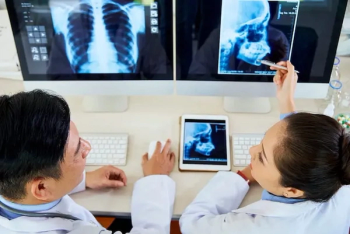By employing a photon-counting computed tomography (PCCT) algorithm to obtain virtual non-contrast (VNC) images from coronary computed tomography angiography (CCTA), radiologists may be able to reduce radiation dosing by nearly 20 percent in comparison to conventional non-contrast CT for coronary artery calcium scoring (CACS).
For the retrospective study, recently published in Radiology, researchers compared VNC images from a PCCT algorithm (PureCalcium) for CCTA versus true non-contrast (TNC) images from CCTA to ascertain any differences in CACS assessment. The 170-patient cohort (mean age of 63) included 111 patients with Agatston scores higher than 0, according to the study.
The researchers found the median Agatson scores were 4.8 for the VNC images and 2.7 for the TNC images and noted “excellent” agreement on plaque classification between VNC and TNC images. Noting that the acquisition of TNC images accounted for 19.7 percent of the total mean dose-length product for the CCTA exam, the study authors suggested that PCCT-derived VNC images may be a viable alternative.
“PureCalcium images from routine CT angiography may obviate the need for a dedicated calcium scoring scan, offering comprehensive information on calcium burden and plaque composition on a single scan while reducing radiation exposure,” wrote lead study author Nina P. Haag, M.D., who is affiliated with the Department of Radiology, Neuroradiology and Nuclear Medicine at Johannes Wesling University Hospital and Ruhr University Bochum in Minden, Germany, and colleagues.
In an accompanying editorial, Hajime Sakuma, M.D., Ph.D., noted that improved dose efficiency and higher spatial resolution are some of the advantages of PCCT in contrast to energy-integrating detector (EID) CT. Dr. Sakuma said the study’s findings with VNC images acquired with PCCT from CCTA images are promising for potential reduction of radiation dosing for CCTA.
“These results suggest that VNC images from contrast-enhanced coronary CTA reconstructed with an updated version of the PureCalcium algorithm can eliminate the need for a separate non-contrast CAC scan, which can reduce the radiation dose of the conventional coronary CTA protocol by a mean of 19.7% + 8.8,” noted Dr. Sakuma, a professor and chair of the Department of Radiology at Mie University Hospital in Japan, and chair of the Japanese Society of Cardiovascular Radiology.
Three Key Takeaways
- Reduced radiation dosing. Employing a photon-counting computed tomography (PCCT) algorithm to generate virtual non-contrast (VNC) images from coronary computed tomography angiography (CCTA) can decrease radiation exposure by nearly 20% compared to conventional non-contrast CT for coronary artery calcium scoring (CACS). This reduction in radiation dose offers a significant advantage in clinical practice, particularly for patients requiring repeated imaging studies.
- Accurate plaque assessment. The study demonstrated "excellent" agreement on plaque classification between VNC and true non-contrast (TNC) images, indicating that PCCT-derived VNC images can provide reliable assessment of coronary artery plaque burden. Despite some misclassifications, particularly in distinguishing between no plaque burden (P0) and minor plaque burden (P1), the overall accuracy rate for plaque burden classification using VNC images was 74 percent. However, a thorough visual analysis of CCTA images may further refine plaque burden classification accuracy, especially in cases of no or minor plaque burden.
- Comprehensive imaging with single scan. PCCT-derived VNC images from routine CT angiography may eliminate the need for a separate non-contrast calcium scoring scan, offering comprehensive information on calcium burden and plaque composition in a single scan. This streamlined approach not only reduces radiation exposure but may enhance workflow efficiency by consolidating imaging protocols. It suggests a potential paradigm shift in coronary imaging practice, wherein PCCT could become integral for both diagnostic and prognostic assessments of coronary artery disease (CAD).
The study authors pointed out that use of the VNC images had a 74 percent accuracy rate (125/170 patients) with the classification of plaque burden. Specifically, 20 patients who had a CAD-RADS P0 classification were misclassified as having CAD-RADS P1 classifications based on VNC images, according to the study authors. They also noted the use of VNC images led to 14 patients with a CAD-RADS P1 classification being misclassified with CAD-RADS P0 classifications.
“While most misclassifications occurred at rates no more than random, PureCalcium CACS misclassified significantly more patients as having minor plaque burden (P1) instead of no plaque burden (P0),” noted Haag and colleagues. “When the PureCalcium CACS is used for patients with no or minor plaque burden, a thorough visual analysis of CCTA images may refine and improve the accuracy of plaque burden classification, but this was not systematically evaluated in our study,”
(Editor’s note: For related content, see “Emerging Concepts with ICM Reduction and Photon Counting for Coronary CT Angiography,” “Study Examines Photon-Counting CT for CAD Detection in Patients Having TAVR Procedures” and “Study: Photon-Counting CT Improves Accuracy of Coronary Stenosis Assessment.”)
Beyond the inherent limitations of a single-center retrospective study, the researchers acknowledged a lack of exploration of interscan reliability between photon-counting CT and energy-integrating detector CT, and evaluation of differences between PureCalcium and TNC images with respect to iterative reconstruction and reconstruction kernel level. They also conceded that patients with higher Agaston scores were underrepresented in the study cohort.





